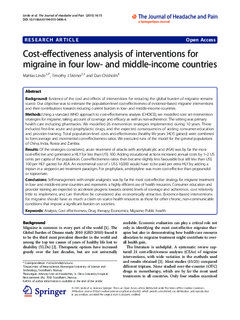| dc.contributor.author | Linde, Mattias | |
| dc.contributor.author | Steiner, Timothy J. | |
| dc.contributor.author | Chisholm, Dan | |
| dc.date.accessioned | 2015-08-20T07:38:47Z | |
| dc.date.accessioned | 2016-04-21T13:28:46Z | |
| dc.date.available | 2015-08-20T07:38:47Z | |
| dc.date.available | 2016-04-21T13:28:46Z | |
| dc.date.issued | 2015 | |
| dc.identifier.citation | The Journal of Headache and Pain 2015, 16(1) | nb_NO |
| dc.identifier.issn | 1129-2377 | |
| dc.identifier.uri | http://hdl.handle.net/11250/2386837 | |
| dc.description.abstract | Background: Evidence of the cost and effects of interventions for reducing the global burden of migraine remains
scarce. Our objective was to estimate the population-level cost-effectiveness of evidence-based migraine interventions
and their contributions towards reducing current burden in low- and middle-income countries.
Methods: Using a standard WHO approach to cost-effectiveness analysis (CHOICE), we modelled core set intervention
strategies for migraine, taking account of coverage and efficacy as well as non-adherence. The setting was primary
health care including pharmacies. We modelled 26 intervention strategies implemented during 10 years. These
included first-line acute and prophylactic drugs, and the expected consequences of adding consumer-education
and provider-training. Total population-level costs and effectiveness (healthy life years [HLY] gained) were combined
to form average and incremental cost-effectiveness ratios. We executed runs of the model for the general populations
of China, India, Russia and Zambia.
Results: Of the strategies considered, acute treatment of attacks with acetylsalicylic acid (ASA) was by far the most
cost-effective and generated a HLY for less than US$ 100. Adding educational actions increased annual costs by 1–2 US
cents per capita of the population. Cost-effectiveness ratios then became slightly less favourable but still less than US$
100 per HLY gained for ASA. An incremental cost of > US$ 10,000 would have to be paid per extra HLY by adding a
triptan in a stepped-care treatment paradigm. For prophylaxis, amitriptyline was more cost-effective than propranolol
or topiramate.
Conclusions: Self-management with simple analgesics was by far the most cost-effective strategy for migraine treatment
in low- and middle-income countries and represents a highly efficient use of health resources. Consumer education and
provider training are expected to accelerate progress towards desired levels of coverage and adherence, cost relatively
little to implement, and can therefore be considered also economically attractive. Evidence-based interventions
for migraine should have as much a claim on scarce health resources as those for other chronic, non-communicable
conditions that impose a significant burden on societies. | nb_NO |
| dc.language.iso | eng | nb_NO |
| dc.publisher | SpringerOpen | nb_NO |
| dc.rights | Navngivelse 3.0 Norge | * |
| dc.rights.uri | http://creativecommons.org/licenses/by/3.0/no/ | * |
| dc.title | Cost-effectiveness analysis of interventions for migraine in four low- and middle-income countries | nb_NO |
| dc.type | Journal article | nb_NO |
| dc.type | Peer reviewed | nb_NO |
| dc.date.updated | 2015-08-20T07:38:47Z | |
| dc.source.volume | 16 | nb_NO |
| dc.source.journal | The Journal of Headache and Pain | nb_NO |
| dc.source.issue | 15 | nb_NO |
| dc.identifier.doi | 10.1186/s10194-015-0496-6 | |
| dc.identifier.cristin | 1251708 | |
| dc.description.localcode | © Linde et al.; licensee Springer. 2015. This is an Open Access article distributed under the terms of the Creative Commons Attribution License (http://creativecommons.org/licenses/by/4.0), which permits unrestricted use, distribution, and reproduction in any medium, provided the original work is properly credited. | nb_NO |

